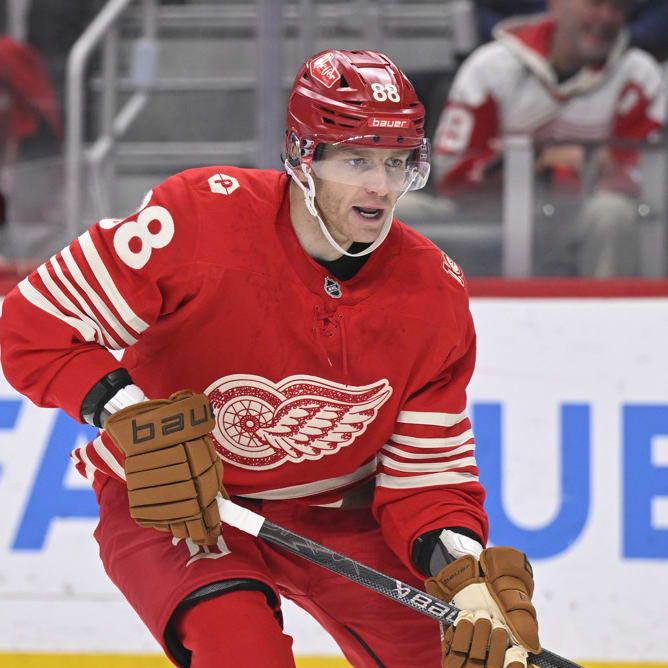2025 Stats
W
5
L
7
SO
0
GAA
3.15
SV%
.875
ROS Projections
2025 Fantasy Outlook
Andersen signed a one-year extension to stay with the Hurricanes for 2025-26. There are performance bonuses for games played, but typically, his workload has been at the mercy of the many injuries and other issues that have kept him off the ice for extended lengths of time. When healthy, Andersen is poised to split the goaltending duties with Pyotr Kochetkov, a tandem that has been quite strong in the last couple of years. Andersen will play all of next season at 36 years old, so his performance could drop, but he was 13-8-1 with a 2.50 GAA and a .899 save percentage over 22 games this season behind one of the stoutest defenses in the league. Read Past Outlooks

Battled puck all night in loss
Andersen made 19 saves in a 5-1 loss to Toronto on Thursday.
ANALYSIS
The first couple goals were purely bad luck. The first went off the post, hit Andersen and trickled over the line. The second hit the back glass and the puck bounced into the slot where a Leaf player drilled it past the stunned netminder. Andersen allowed four goals. He has really struggled over the last month. His last regulation win was Nov. 8, and he's 1-4-2 in seven starts. Andersen has allowed 23 goals in that span.
The first couple goals were purely bad luck. The first went off the post, hit Andersen and trickled over the line. The second hit the back glass and the puck bounced into the slot where a Leaf player drilled it past the stunned netminder. Andersen allowed four goals. He has really struggled over the last month. His last regulation win was Nov. 8, and he's 1-4-2 in seven starts. Andersen has allowed 23 goals in that span.
NHL Stats
Loading Goalie Stats...
2025 NHL Game Log
2025
2024
2023
2022
2021
2020
2019
2018
2017
2016
2025 NHL Game Log
Loading Goalie Game Log...
2025–26 Time On Ice Stats
- Average Time On Ice: 59:51
Hurricanes Depth Chart
Our full team depth charts are reserved for RotoWire subscribers.
Subscribe Now
Past Fantasy Outlooks
2024
2023
2022
2021
2020
2019
2018
2017
2016
2015
2014
Andersen is an above-average goalie with a propensity for injury. He's played a full season just once in his last four campaigns, and he's seen action in only 50 of the Canes' possible 162 over the last two years. He put up a 13-2-0 record in 16 starts in 2023-24 and delivered a sparkling 1.82 GAA and .932 save percentage. Still, it's hard to imagine that at 34, Andersen is going to suddenly get healthy or find another gear. He's more risk than reward as a No. 1 or 2 goalie, but if you can stash him as a three, then you'll be in the hunt for a title.
More Fantasy News

Starting against Toronto
Andersen will defend the home crease against the Maple Leafs on Thursday, Walt Ruff of the Hurricanes' official site reports.
ANALYSIS
Subscribe now to instantly reveal our take on this news.
Subscribe now to instantly reveal our take on this news.

Losing streak continues Wednesday
Andersen stopped 14 of 17 shots in Wednesday's 4-2 loss to the Rangers, with New York's final goal getting scored into an empty net.
ANALYSIS
Subscribe now to instantly reveal our take on this news.
Subscribe now to instantly reveal our take on this news.

Guarding cage versus Rangers
Andersen will tend the twine at home versus the Rangers on Wednesday, Ryan Henkel of The Hockey News reports.
ANALYSIS
Subscribe now to instantly reveal our take on this news.
Subscribe now to instantly reveal our take on this news.

Struggles against low volume
Andersen stopped 17 of 20 shots in Sunday's 4-1 loss to the Sabres.
ANALYSIS
Subscribe now to instantly reveal our take on this news.
Subscribe now to instantly reveal our take on this news.

Starting in Buffalo
Andersen will defend the road net against the Sabres on Sunday, Heather Engel of NHL.com reports.
ANALYSIS
Subscribe now to instantly reveal our take on this news.
Subscribe now to instantly reveal our take on this news.
Latest Fantasy Rumors

Poised to start against Rangers
Andersen is working in the starter's crease ahead of Wednesday's home clash with the Rangers, Walt Ruff of the Hurricanes' official site reports, indicating he'll be in goal.
ANALYSIS
Andersen will be making consecutive starts for the first time since late October despite having lost four straight contests. In those defeats, the veteran backstop is 0-2-2 with a 3.29 GAA and an .854 save percentage. With Pyotr Kochetkov sidelined by a lower-body injury, the Canes could use Brandon Bussi in an upcoming game.
Andersen will be making consecutive starts for the first time since late October despite having lost four straight contests. In those defeats, the veteran backstop is 0-2-2 with a 3.29 GAA and an .854 save percentage. With Pyotr Kochetkov sidelined by a lower-body injury, the Canes could use Brandon Bussi in an upcoming game.

















